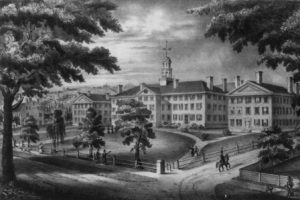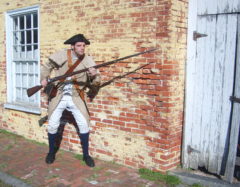Chronicling the History of American Literary Studies
Advanced and professional studies in American literature blossomed slowly and painstakingly, for it took nearly 250 years for studies in American literature to gain any substantial ground, and even then, the studies were far from prominent. The reasons behind American literature’s crawl toward relevancy are manifold; however, one problem was produced at the onset of American colonization. The question that has plagued scholars for more than a century is whether early American writings are “American” or “British,” and this dilemma rages because some critics consider early American writings as purely British due to the fact that America remained a group of English colonies from the early 1600s to the late 1700s (Kropf 18). Nevertheless, the earliest approaches to American literary studies were either eclectic, where scholars recognized any text by a person on American soil as “American,” or nationalistic, where scholars only denote an American text that culturally or politically articulates and stimulates the national literary identity (Kropf 17-18). Even with this opposing view, American literary criticism did not function as a sphere of study or inquiry due in part to a lack of interest and a lack of literature that merited study, for as Kropf writes, “Eighteenth-century literature was not literary in any meaningful sense; that is, was not original, romantic, or especially ‘expressive’ in nature” (18).
Meanwhile, eclectic and nationalistic proponents were/are in accordance that the Revolutionary period in America provides a moment in history when literary culture first becomes visible. This is the time when “opinion first begins to polarize around liberal demands for cultural as well as political independence versus Tory loyalty to British and European supremacy” (Graff 106). While a devotion to patriotism was immense, the study of American literature was rare, for the ability to write and speak persuasively claimed precedence over reading (Miller 16). Through war, which eventually became an even larger factor in the expansion of American literary studies, criticisms of literature begin to arise between progressives versus retrogrades and radicals versus conservatives (Graff 105). However, despite these conflicted reactions to literature, no formal critical study of American literature existed until the mid to late 1800s. According to Elizabeth Renker, American literature begins to receive minimal attention in American colleges in the 1870s, and in the 1880s, a few colleges offer American literature as an independent course: Dartmouth, Smith, Wellesley, Mount Holyoke, Wisconsin, Indiana, Notre Dame, and Iowa (352).

While some universities added courses devoted to American literature, most institutions considered the subject as unscientific, irrelevant, or too feminine in nature; therefore, American literature continued to wage a heated battle for space in English departments and for acceptance during the first four decades of the twentieth century (Renker 347). Renker goes on to write, “The institutional expression of the notion that American literature was a subject fit for women but not for serious male scholars was dramatic” (352). While many university leaders looked at most literature as effeminate, a majority of institutions focused devoutly on science. As Bruce McComiskey writes in English Studies: An Introduction to the Discipline(s), by the 1880s, most American universities based their values on the model of the German research university where scientific methods were the paramount form of academic scholarship (6). Therefore, in order to combat the lack of science, along with the femininity associated with studying literature, “Professionalization demanded that English reshape its soft image, and philology emerged as a powerful tool for effecting this defeminization,” and in time, “Scientific methods of philology gave the profession of modern languages ‘weight and dignity’” (Renker 348). Unfortunately, philology could not and would not support the study of American literature. “Although philology had been an effective tool for establishing English in the university, it was not deployed in the service of American literature, too recent and too thin a body of texts to lend itself to philological investigation” (Renker 350).
Even though philology typically only applied to British, Greek, or Roman literature, the paramount basis for study of American literature finally occurred at the conclusion of WWI. “America’s place on the battlefield was in fact a great boon for American literature’s professional fortunes. The surge of nationalism produced by the Great War fostered an interest in America’s literature both here and abroad” (Renker 357). In fact, Renker goes on to note that almost twice as many American literature classes were offered at universities after the war’s end, and American literature began to have importance in numerous European countries because America’s culture and institutions became more respected (357). Prominent schools that had not prioritized American literary studies now had reason to integrate new programs and courses. For example, The American Studies Group at Yale endorsed their more advanced program by articulating that it would make major contributions to the mutual understandings of people around the world in order to secure peace and would provide foreign students with the opportunity to discover the principles of American democracy (Holzman 79). Furthermore, with this newfound desire to study American literature, myriad branches of criticism would begin to form, and other areas of study continued to grow after WWII.
Works Cited
Graff, Gerald. “An Ideological Map of American Literary Criticism.” Revue Francaise D’etudes Americaines 16 (1983): 101-21. JSTOR. Web. 13 September 2016.
Holzman, Michael. “The Ideological Origins of American Studies at Yale.” American Studies 40.2 (1999): 71-99. JSTOR. Web. 13 September 2016.
Kropf, Carl R. “The Nationalistic Criticism of Early American Literature.” Early American Literature 18.1 (1983): 17-30. JSTOR. Web. 13 September 2016.
McComiskey, Bruce, ed. English Studies: An Introduction to the Discipline(s). Urbana, IL: NCTE, 2006. Print.
Miller, Thomas P. The Evolution of College English: Literacy Studies from the Puritans to the Postmoderns. Pittsburgh: University of Pittsburgh Press, 2011. Print.
Renker, Elizabeth. “Resistance and Change: The Rise of American Literature Studies.” American Literature 64.2 (1992): 347-365. JSTOR. Web. 13 September 2016.
*Click on the link below to take a short survey focusing on your notions regarding early American literary studies:
https://docs.google.com/forms/u/1/d/10iquqG6RAfWyd4eJBv7aEyuJ-xqbEEqjwVQoR3F6mXE/edit
